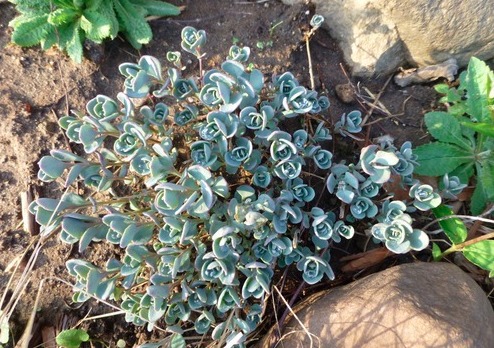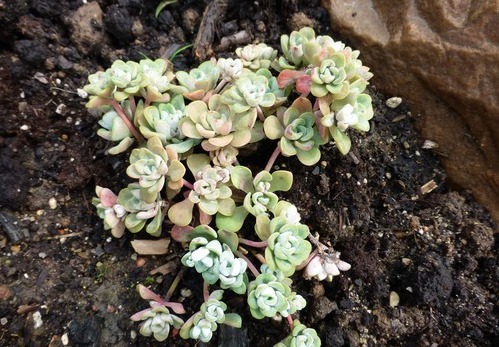Content
Evers sedum (Sedum ewersii) - garden succulent, ground cover. The flower is distinguished by the plasticity of powerful stems that can take a creeping or ampelous shape. Sedum "Eversa" is unpretentious to the composition of the soil and is resistant to harsh climatic conditions.
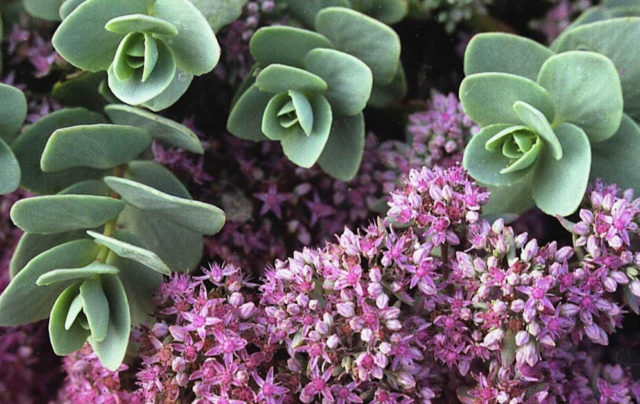
Powerful rhizome and aerial outgrowths of plastic stems allow stonecrop "Evers" to grow and develop on a steep wall
Description of stonecrop Evers
Sedum is a herbaceous rhizome perennial. Natural habitats are rocky mountains, sandy riverbeds, pebbles of Altai, Central Asia and Northwest China. Stonecrop grows as a low bush with rooting shoots.
Elongated reddish branches with fleshy glossy leaves rise 10-20 cm above the ground and spread out in a solid half-meter carpet. Blooming sedum is a honey plant.
Young shoots of Evers sedum are fragile, but plastic, enveloped in whorls of 2 small leaves 1.5-2 cm heart-shaped. By mid-July, umbrellas of small numerous flowers bloom at the ends of the stems, in the apical sinuses. The star-shaped purple-pink petals open in unison and do not fall until the end of August. Faded inflorescences of sedum become bright brown and have a decorative appearance.
In autumn, the foliage falls off, exposing the already lignified reddish stems. This property of sedum allows it to survive frost. In the spring, the branches are again covered with shoots.
There are two types of stonecrop:
- Round-leaved (Sedum ewersii var. Cyclopbyllum), a prominent representative is the Nanum variety. Relatively high bush, towering up to 20 cm above the ground. Shoots reach 25-30 cm, form a carpet up to 0.5 m. The leaf plates are small, pale green. Sedum umbrellas are rare, pink. Grow more like greenery than flowering plant.
- Same-leaved (Sedum ewersii var. Homophyllum). Miniature carpet-like bush 10 cm high, 35-40 cm in diameter. It is distinguished by light gray-green leaves. It blooms sparsely, but the Rosse Carpet is a solid lilac-pink carpet.
Sedum's endurance and hassle-free care increases the prevalence of sedum among succulent hobbyists. Breeders constantly surprise growers with new varieties.
The form of stonecrop "Eversa" with blue leaves becomes the pride of the collection. The cultivar is called "Blue Pearl" (Sansparkler Blue Pearl). Sedum forms dense bumps with bright purple leaves covered with a bluish bloom, and pale pink umbrellas of flower stars. They are grown in the open sun. In the shade, the stems stretch out, the leaves turn green.
Application in landscape design
Sedum "Eversa" is planted on lawns, flower beds and around conifers. Hanging baskets and containers with it are used to decorate terraces, gazebos and pergolas.
The sedum is able to decorate:
- retaining walls;
- rock gardens;
- rockeries;
- rocky or gravel gardens.
Sedum "Evers" serves as an excellent background for tall single trees or flowers, participates in microborders.
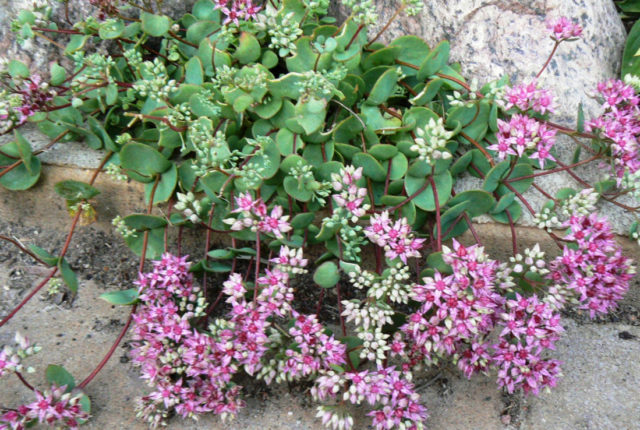
From sedum "Evers" beautiful borders are obtained, they are not replaceable for landscaping slopes and slopes
Combines sedum "Eversa" with other types of succulents, high and low flower crops and conifers.
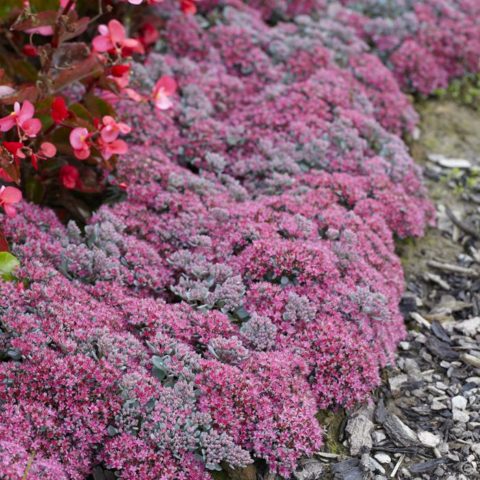
Other succulents can also be planted in the flower garden.
Breeding features
Stonecrop Evers has no problem getting new copies. All vegetative propagation methods are suitable for him:
- cuttings;
- dividing the bush;
- seeds.
All stages of sedum spreading are carried out in the spring, during the period of active sap flow. Sedum is propagated by seeds in the fall, because their germination is lost.
Growing sedum from cuttings
Eversa sedum grows roots where it touches the ground. The most surefire way to get a new jacket is to take advantage of an established process.

A stalk with several pairs of apical leaves is suitable for reproduction.
The second method is to cut off the process of the sedum 1 cm below the leaf node at an angle, stick it into damp ground with a slope so that the sinus deepens. Place the seedling plant for rooting in a diffused shade, water sparingly.
Dividing the bush
It is recommended to transplant stonecrop "Evers" after 5 years. At the time of excavation of the sedum curtain, the rhizome should be divided into "delenki" so that each has a bud of growth and a healthy root.
Treat the cuts with crushed coal. Dry the sedum delenki in the shade and plant the seedlings in a few hours.
Seed propagation
Propagating Evers sedum by seeds is a laborious process, rarely used by gardeners. Only freshly harvested seeds have good germination, so autumn sowing is more productive.
Planting and caring for stonecrop Evers
Sedum "Eversa" is unpretentious to the composition of the soil, grows in any climatic conditions. But the density and juiciness of the greenery, the brightness of the color, the splendor of the flowering depend on the correct planting and subsequent care.
Recommended timing
Eversa sedum takes root and adapts better in spring. In the fall, it is planted 2 weeks before the expected frost.
Site selection and soil preparation
In open areas, stonecrop "Eversa" blooms magnificently. The greens grow dense, juicy. The bush can withstand direct sunlight.
A thick shadow is contraindicated for sedum: the leaves thin and turn pale, the stems stretch out, lose their attractiveness. Blooms poorly, rarely.
The sedum has no special requirements for the composition of the soil. In order for the succulent to grow, develop and bloom, it is necessary to dilute the loam with peat, loosen the dense earth with sand.
Evers' Sedum benefits from neutral soil. If there is a lot of humus or compost in the ground, add wood ash.
Landing algorithm
The hole is made narrow, slightly larger than the rhizome. The bottom is covered with a thick layer of drainage so that the roots of the sedum do not rot from the stagnant moisture of autumn rains or spring floods. Pour soil on top.
Further actions:
- Place sedum in the planting pit.
- Spread the roots.
- Cover with prepared soil, compact.
To maintain soil moisture, it is worth mulching with humus or other material, watering.
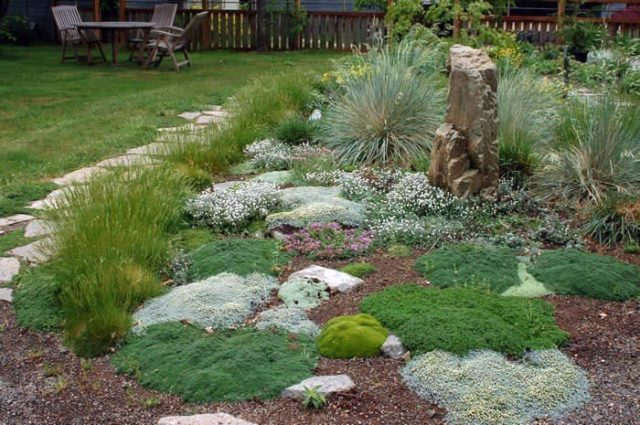
Sedum "Evers" grows well on sandy loam and loamy soils
Carpet flower beds are built by combining different types of stonecrops. In this way, the unsightly corners of the flower bed, construction waste and other rubbish are hidden.
Growing rules
It is believed that sedum "Evers" is an unpretentious plant, it was planted and forgotten, but this is not so. In order for a flower to perform its decorative function, it needs competent care.
Watering and feeding
Frequent watering of Evers sedum is not required, it fully justifies its involvement in the Tolstyankovye family. The ability of sedum to accumulate moisture in the leaves protects the plant from drought for a long time. It is enough to water the soil well once a week.With regular rains, sedum is not moistened at all. In dry summer, stonecrop is watered after 4-5 days.
The Evers sedum is fed with a complex fertilizer (nitrogen, phosphorus, potassium):
- in early spring;
- before flowering in early July;
- in autumn in the first decade of September.
Fertilize sedum "Eversa" better with a liquid solution, the next day after watering. Thus, the roots of the flower receive all the necessary components gradually and safely. Gardeners recommend fertilizing succulents.
Weeding and loosening
Sedum is afraid of weeds, the emerging grass is immediately weeded. If the soil is dense, after each watering, the crust is removed from the surface, which prevents the penetration of air to the roots, the evaporation of excess moisture.
Pruning
Many gardeners grow a ground cover for carpet greenery, and not for flowering. In this case, the buds are cut or the fading umbrellas are removed, stimulating further flowering. To preserve the decorativeness of stonecrop, unattractive shoots are cut or shortened throughout the entire period.
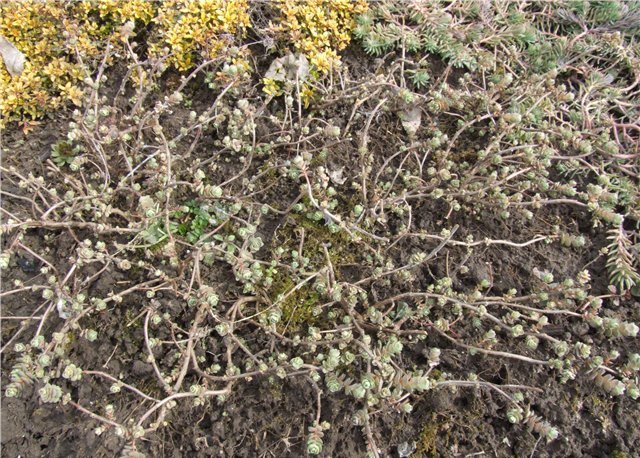
Sedum pruning is done immediately after the flower has faded
Evers' sedum is a deciduous perennial. By winter, all the leaves fly off. Bare woody branches remain. In the spring, near stonecrop bushes, they will again be covered with new buds.
Wintering
The sedum is frost-resistant. The ground cover easily tolerates winter without shelter under a snow cover in central Russia. In areas of a harsh climate, where there is a long snowless period at -10 -15 ° C, stonecrop is spud with humus. In the spring, when the snow melts, the rhizome will receive additional nutrition from the mulch.
Transfer
After 5 years, stonecrop "Eversa" loses its presentable appearance - it is aging. The foliage and inflorescences become smaller, the stems are bare. In this case, the sedum is transplanted to a new location.
Transplant algorithm:
- Prune branches.
- Dig up a bush.
- Examine the roots.
- Choose a young shoot of the rhizome with a large number of growth buds.
- Cut with a sterile sharp knife.
- Treat the sections with charcoal, dry.
- Drop off at a prepared place.
Water the sedum seedling once a week, and weed the weeds. It is better to rejuvenate the Evers sedum in spring - healthy buds of growth are clearly expressed. Prepare a place in the fall, and transplant in the spring.
Pests and diseases
Sedum "Eversa" is not susceptible to disease. The only danger threatening stonecrop is excess moisture. There are various rot caused by fungi, viruses, bacteria, which can be protected from good drainage, prevention and fungicides.
The invasion of parasitic insects is prevented by general preventive spraying with insecticides. If the “neighbors” are healthy, the stonecrop of “Evers” is not in danger.
Possible problems
Evers sedum has strong immunity, but the warm and humid environment creates significant problems. It happens that stonecrop has signs of fungal diseases:
- white or gray bloom (powdery mildew or gray rot);
- red spots on the leaves (sooty mushroom);
- spots caused by various viruses.
All these problems are removed by treatment with drugs: "Fundazol" (antifungal), "Arilin-B" (bacterial). Spraying with Bordeaux liquid, which is carried out in early spring for the entire garden, is considered a reliable way to avoid treatment.
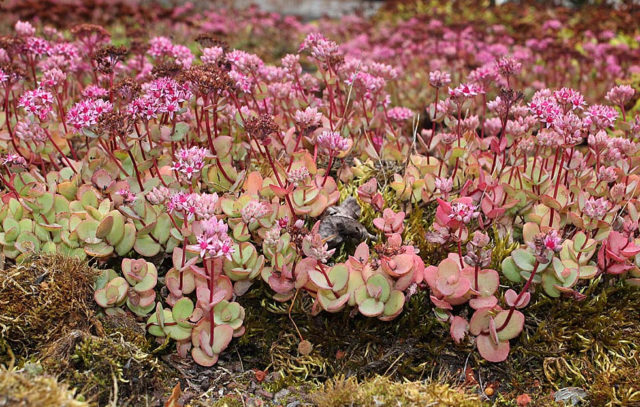
Low temperatures and high humidity contribute to the development of fungal diseases
The parasitic beetles that annoy stonecrop are fought both mechanically (collected by hand), biologically (with phytoncides - herbal infusions and decoctions) or chemically (with Aktellik, Fitoverm insecticides).
Healing properties
The sedum has healing properties. Herbalists prepare infusions from Evers sedum for disinfection and healing of wounds, lotions with it dissolve abscesses. Lotion is used to wipe problem skin of the face and body. Applied as a biostimulant.
The sedum "Eversa" contains:
- flavonoids;
- anthraquinones;
- phenols;
- alkaloids;
- vitamin C.
It also includes acids: malic, citric, oxalic and many other healing substances. In folk medicine, the aerial parts of sedum are used.
Interesting Facts
In botanical reference books, sedum "Evers" is listed under the Latin name Sedum ewersii Ledeb. Named after the German scientist Karl Christian Friedrich von Ledebour, a traveler in the Russian service, who in 1829 discovered and described its appearance in the book "Flora of Altai".
Conclusion
Evers sedum forms a dense carpet, green or blooming with mauve balls, covering a large area of soil. Unpretentious to growing conditions, in demand by flower growers. Eversa sedum is used both in single plantings and container decor, as well as in compositions with flowers and trees.
